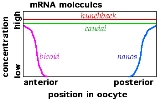
Drosophila embryogenesis
Encyclopedia
Drosophila embryogenesis, the process by which Drosophila
(fruit fly) embryos form, is a favorite model system
for genetic
ists and developmental biologists
studying embryogenesis
. The small size, short generation time, and large brood size make it ideal for genetic studies. Transparent embryos facilitate developmental studies. Drosophila melanogaster
was introduced into the field of genetic experiments by Thomas Hunt Morgan
in 1909.
, the larval stage fly will develop and hatch at a stage of its life known as the first larval instar. Cells that will produce adult structures are put aside in imaginal disc
s. During the pupal stage, the larval body breaks down as the imaginal disks grow and produce the adult body. This process is called complete metamorphosis.
The mother fly produces oocyte
s that already have anterior-posterior and dorsal-ventral axes defined by maternal activities.
Embryogenesis in Drosophila is unique among model organisms in that cleavage occurs in a syncytium
. About 5,000 nuclei accumulate in the unseparated cytoplasm of the oocyte before they migrate to the surface and are encompassed by plasma membranes to form cells surrounding the yolk sac. Early on, the germ line
segregates from the somatic cells through the formation of pole cells at the posterior end of the embryo.
Like other triploblastic
metazoa
, gastrulation
leads to the formation of three germ layer
s: the endoderm, mesoderm, and ectoderm. The mesoderm invaginates from the ventral furrow (VF), as do the ectoderm that will give rise to the midgut. The pole cells are internalized by a different route.
Germ band elongation involves many rearrangements of cells, and the appearance of distinct differences in the cells of the three germ bands and various regions of the embryo.
The posterior region (including the hindgut) expands and extends towards the anterior pole along the dorsal side of the embryo. The earliest signs of segmentation appear during this phase with the formation of parasegmental furrows. This is also when the tracheal pits form, the first signs of structures for breathing.
Germ band retraction returns the hindgut to the dorsal side of the posterior pole and coincides with overt segmentation
. The remaining stages involve the internalization of the nervous system (ectoderm) and the formation of internal organs (mainly mesoderm).
. The development of Drosophila is particularly well studied, and it is representative of a major class of animals, the insects or insecta
. Other multicellular organisms sometimes use similar mechanisms for axis formation, although the relative importance of signal transfer between the earliest cells of many developing organisms is greater than in the example described here.

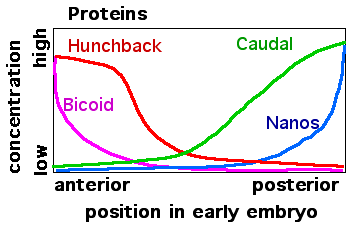 The building-blocks of anterior-posterior axis patterning in Drosophila are laid out during egg formation (oogenesis
The building-blocks of anterior-posterior axis patterning in Drosophila are laid out during egg formation (oogenesis
), well before the egg is fertilized and deposited. The developing egg (oocyte
) is polarized by differentially localized mRNA
molecules.
The genes that code for these mRNAs, called maternal effect genes, encode for proteins that get translated upon fertilization to establish concentration gradients that span the egg. Bicoid and hunchback are the maternal effect genes that are most important for patterning of anterior parts (head and thorax) of the Drosophila embryo. Nanos and Caudal are maternal effect genes that are important in the formation of more posterior abdominal segments of the Drosophila embryo.
Cytoskeletal
elements such as microtubule
s are polarized within the oocyte and can be used to allow the localization of mRNA molecules to specific parts of the cell. Maternally synthesized bicoid mRNAs attach to microtubules and are concentrated at the anterior ends of forming Drosophila eggs. In unfertilized eggs, transcripts are still strictly localized at the tip, but immediately after fertilization, a small mRNA gradient is formed in the anterior 20% of the eggs.
nanos mRNA also attaches to a Drosophila egg's cytoskeleton but is concentrated at the posterior end of the egg.
hunchback and caudal mRNAs lack special location control systems and are fairly evenly spread throughout the entire interior of the egg cells.
When the mRNAs from the maternal effect genes are translated
into proteins, a Bicoid protein gradient forms at the anterior end of the egg. Nanos protein forms a gradient at the posterior end. The Bicoid protein blocks translation of caudal mRNA so Caudal protein is made only in the posterior part of the cell. Nanos protein binds to the hunchback mRNA and blocks its translation in the posterior end of Drosophila embryos.
The Bicoid, Hunchback, and Caudal proteins are transcription factor
s. Bicoid has a DNA-binding homeodomain
that binds both DNA and the nanos mRNA. Bicoid binds a specific RNA sequence in the 3' untranslated region, called the Bicoid 3'-UTR regulatory element
, of caudal mRNA and blocks translation.
Hunchback protein levels in the early embryo are significantly augmented by new hunchback gene transcription and translation of the resulting zygotically
produced mRNA. During early Drosophila embryogenesis there are nuclear divisions without cell division. The many nuclei that are produced distribute themselves around the periphery of the cell cytoplasm. Gene expression in these nuclei is regulated by the Bicoid, Hunchback, and Caudal proteins. For example, Bicoid acts as a transcriptional activator of hunchback gene transcription.
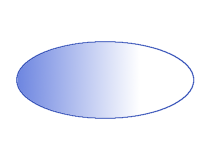
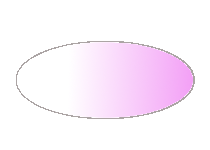
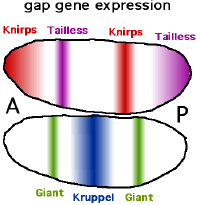 The other important function of the gradients of Bicoid, Hunchback, and Caudal proteins is in the transcriptional regulation of other zygotically expressed proteins. Many of these are the protein products derived from members of the "gap" family of developmental control genes. giant, huckebein, hunchback, knirps, Krüppel and tailless are all gap gene
The other important function of the gradients of Bicoid, Hunchback, and Caudal proteins is in the transcriptional regulation of other zygotically expressed proteins. Many of these are the protein products derived from members of the "gap" family of developmental control genes. giant, huckebein, hunchback, knirps, Krüppel and tailless are all gap gene
s. Their expression patterns in the early embryo are determined by the maternal effect gene products and shown in the diagrams on the right side of this page. The gap genes are part of a larger family called the segmentation genes. These genes establish the segmented body plan of the embryo along the anterior-posterior axis. The segmentation genes specify 14 parasegments that are closely related to the final anatomical segments. The gap genes are the first layer of a hierarchical cascade of the segmentation control genes.
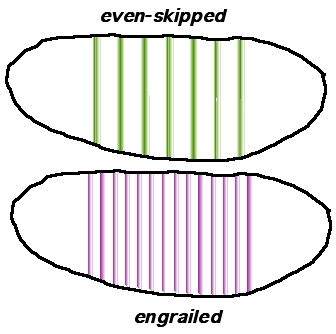 Two additional classes of segmentation genes are expressed after the gap gene products. The pair-rule genes are expressed in striped patterns of seven bands perpendicular to the anterior-posterior axis (see Figure 6, even-skipped). These patterns of expression are established within the syncytial blastoderm. After these initial patterning events, cell membranes form around the nuclei of the syncytial blastoderm converting it to a cellular blastoderm.
Two additional classes of segmentation genes are expressed after the gap gene products. The pair-rule genes are expressed in striped patterns of seven bands perpendicular to the anterior-posterior axis (see Figure 6, even-skipped). These patterns of expression are established within the syncytial blastoderm. After these initial patterning events, cell membranes form around the nuclei of the syncytial blastoderm converting it to a cellular blastoderm.
 The expression patterns of the final class of segmentation genes, the segment polarity genes, are then fine-tuned by interactions between the cells of adjacent parasegments (see the example, engrailed, Figure 7). The Engrailed protein is a transcription factor (yellow in Figure 7) that is expressed in one row of cells at the edge of each parasegment. This expression pattern is initiated by the pair-rule genes (like even-skipped) that code for transcription factors that regulate the engrailed gene's transcription in the syncytial blastoderm.
The expression patterns of the final class of segmentation genes, the segment polarity genes, are then fine-tuned by interactions between the cells of adjacent parasegments (see the example, engrailed, Figure 7). The Engrailed protein is a transcription factor (yellow in Figure 7) that is expressed in one row of cells at the edge of each parasegment. This expression pattern is initiated by the pair-rule genes (like even-skipped) that code for transcription factors that regulate the engrailed gene's transcription in the syncytial blastoderm.
Cells that make Engrailed can make the cell-to-cell signaling protein Hedgehog (green in Figure 7). The motion of Hedgehog is limited by its lipid modification, and so Hedgehog activates a thin stripe of cells anterior to the Engrailed-expressing cells. Only cells to one side of the Engrailed-expressing cells are competent to respond to Hedgehog because they express the receptor protein Patched (blue in Figure 7). Cells with activated Patched receptor make the Wingless protein (red in Figure 7). Wingless is a secreted protein that acts on the adjacent rows of cells by activating its cell surface receptor, Frizzled.
Wingless acts on Engrailed-expressing cells to stabilize Engrailed expression after the cellular blastoderm forms. The Naked cuticle protein is induced by Wingless to limit the number of rows of cells that express Engrailed. The short-range, reciprocal signaling by Hedgehog and Wingless, held in check by the Patched and Naked proteins, stabilizes the boundary between each segment. The Wingless protein is called "wingless" because of the phenotype
of some wingless mutants. Wingless and Hedgehog also function in multiple tissues later in embryogenesis and also during metamorphosis.
The transcription factors that are coded for by segmentation genes regulate yet another family of developmental control genes, the homeotic selector gene
s. These genes exist in two ordered groups on Drosophila chromosome 3. The order of the genes on the chromosome reflects the order that they are expressed along the anterior-posterior axis of the developing embryo. The Antennapedia group of homeotic selector genes includes labial, antennapedia, sex combs reduced, deformed, and proboscipedia. Labial and Deformed proteins are expressed in head segments where they activate the genes that define head features. Sex-combs-reduced and Antennapedia specify the properties of thoracic segments. The bithorax group of homeotic selector genes control the specializations of the third thoracic segment and the abdominal segments.
In 1995, the Nobel Prize for Physiology or Medicine
was awarded for studies concerning the genetic control of early embryonic development to Christiane Nüsslein-Volhard
, Edward B. Lewis
and Eric Wieschaus
. Their research on genetic screening for embryo patterning mutants revealed the role played in early embryologic development by Homeobox gene
s like bicoid. An example of a homeotic mutation is the so-called antennapedia mutation. In Drosophila, antennae and legs are created by the same basic "program", they only differ in a single transcription factor. If this transcription factor is damaged, the fly grows legs on its head instead of antennae. See images of this "antennapedia" mutant and others, at FlyBase.
. Gurken
inhibits the production of PIPE protein by interacting with Torpedo receptor on flanking oocyte follicle cells. PIPE positive cells are able to secrete dorsal protein and form the ventral side of the egg, while PIPE negative cells do not secrete dorsal protein and form the dorsal side of the egg.
Dorsal induces the transcription of two genes twist & snail while repressing zerknüllt
& decapentaplegic
.
Intra-membranous dorsal receptor proteins, known as Toll receptors are responsible for transporting dorsal protein into the embryonic nuclei. These Toll receptors are the product of Toll
gene, and are uniformly spaced across the embryoinic plasma-membrane.
Since dorsal protein is secreted by PIPE positive-ventral follicular cells of an egg, dorsal protein enters the embryo to the ventral side. Once transported into the nuclei, dorsal protein is most concentrated at the ventral side of the embryo.
This process sets up a gradient differential between the ventral and dorsal side of an immature embryo, the repression or induction of these four genes are differentially regulated. For example;
Drosophila
Drosophila is a genus of small flies, belonging to the family Drosophilidae, whose members are often called "fruit flies" or more appropriately pomace flies, vinegar flies, or wine flies, a reference to the characteristic of many species to linger around overripe or rotting fruit...
(fruit fly) embryos form, is a favorite model system
Model organism
A model organism is a non-human species that is extensively studied to understand particular biological phenomena, with the expectation that discoveries made in the organism model will provide insight into the workings of other organisms. Model organisms are in vivo models and are widely used to...
for genetic
Genetics
Genetics , a discipline of biology, is the science of genes, heredity, and variation in living organisms....
ists and developmental biologists
Developmental biology
Developmental biology is the study of the process by which organisms grow and develop. Modern developmental biology studies the genetic control of cell growth, differentiation and "morphogenesis", which is the process that gives rise to tissues, organs and anatomy.- Related fields of study...
studying embryogenesis
Embryogenesis
Embryogenesis is the process by which the embryo is formed and develops, until it develops into a fetus.Embryogenesis starts with the fertilization of the ovum by sperm. The fertilized ovum is referred to as a zygote...
. The small size, short generation time, and large brood size make it ideal for genetic studies. Transparent embryos facilitate developmental studies. Drosophila melanogaster
Drosophila melanogaster
Drosophila melanogaster is a species of Diptera, or the order of flies, in the family Drosophilidae. The species is known generally as the common fruit fly or vinegar fly. Starting from Charles W...
was introduced into the field of genetic experiments by Thomas Hunt Morgan
Thomas Hunt Morgan
Thomas Hunt Morgan was an American evolutionary biologist, geneticist and embryologist and science author who won the Nobel Prize in Physiology or Medicine in 1933 for discoveries relating the role the chromosome plays in heredity.Morgan received his PhD from Johns Hopkins University in zoology...
in 1909.
Life cycle
Drosophila display a holometabolous method of development, meaning that they have three distinct stages of their post-embryonic life cycle, each with radically different body plans: larva, pupa and finally, adult. The machinery necessary for the function and smooth transition between these three phases develops during embryogenesis. During embryogenesisEmbryogenesis
Embryogenesis is the process by which the embryo is formed and develops, until it develops into a fetus.Embryogenesis starts with the fertilization of the ovum by sperm. The fertilized ovum is referred to as a zygote...
, the larval stage fly will develop and hatch at a stage of its life known as the first larval instar. Cells that will produce adult structures are put aside in imaginal disc
Imaginal disc
An imaginal disc is one of the parts of a holometabolous insect larva that will become a portion of the outside of the adult insect during the pupal transformation. Contained within the body of the larva, there are pairs of discs that will form, for instance, the wings or legs or antennae or other...
s. During the pupal stage, the larval body breaks down as the imaginal disks grow and produce the adult body. This process is called complete metamorphosis.
The mother fly produces oocyte
Oocyte
An oocyte, ovocyte, or rarely ocyte, is a female gametocyte or germ cell involved in reproduction. In other words, it is an immature ovum, or egg cell. An oocyte is produced in the ovary during female gametogenesis. The female germ cells produce a primordial germ cell which undergoes a mitotic...
s that already have anterior-posterior and dorsal-ventral axes defined by maternal activities.
Embryogenesis in Drosophila is unique among model organisms in that cleavage occurs in a syncytium
Syncytium
In biology, a syncytium is a large cell-like structure; filled with cytoplasm and containing many nuclei. Most cells in eukaryotic organisms have a single nucleus; syncytia are specialized forms used by various organisms.The term may also refer to cells that are connected by specialized membrane...
. About 5,000 nuclei accumulate in the unseparated cytoplasm of the oocyte before they migrate to the surface and are encompassed by plasma membranes to form cells surrounding the yolk sac. Early on, the germ line
Germline
In biology and genetics, the germline of a mature or developing individual is the line of germ cells that have genetic material that may be passed to a child.For example, gametes such as the sperm or the egg, are part of the germline...
segregates from the somatic cells through the formation of pole cells at the posterior end of the embryo.
Like other triploblastic
Triploblasty
Triploblasty is a condition of the blastula in which there are three primary germ layers: the ectoderm, mesoderm, and endoderm. The germ layers form during gastrulation of the blastula. Additionally, the term may refer to any ovum in which the blastoderm splits into three layers.All higher and...
metazoa
Animal
Animals are a major group of multicellular, eukaryotic organisms of the kingdom Animalia or Metazoa. Their body plan eventually becomes fixed as they develop, although some undergo a process of metamorphosis later on in their life. Most animals are motile, meaning they can move spontaneously and...
, gastrulation
Gastrulation
Gastrulation is a phase early in the embryonic development of most animals, during which the single-layered blastula is reorganized into a trilaminar structure known as the gastrula. These three germ layers are known as the ectoderm, mesoderm, and endoderm.Gastrulation takes place after cleavage...
leads to the formation of three germ layer
Germ layer
A germ layer, occasionally referred to as a germinal epithelium, is a group of cells, formed during animal embryogenesis. Germ layers are particularly pronounced in the vertebrates; however, all animals more complex than sponges produce two or three primary tissue layers...
s: the endoderm, mesoderm, and ectoderm. The mesoderm invaginates from the ventral furrow (VF), as do the ectoderm that will give rise to the midgut. The pole cells are internalized by a different route.
Germ band elongation involves many rearrangements of cells, and the appearance of distinct differences in the cells of the three germ bands and various regions of the embryo.
The posterior region (including the hindgut) expands and extends towards the anterior pole along the dorsal side of the embryo. The earliest signs of segmentation appear during this phase with the formation of parasegmental furrows. This is also when the tracheal pits form, the first signs of structures for breathing.
Germ band retraction returns the hindgut to the dorsal side of the posterior pole and coincides with overt segmentation
Segmentation (biology)
Segmentation in biology refers to either a type of gastrointestinal motility or the division of some animal and plant body plans into a series of repetitive segments. This article will focus on the segmentation of animal body plans, specifically using the examples of the phyla Arthropoda,...
. The remaining stages involve the internalization of the nervous system (ectoderm) and the formation of internal organs (mainly mesoderm).
Anterior-posterior axis patterning in Drosophila
One of the best understood examples of pattern formation is the patterning along the future head to tail (antero-posterior) axis of the fruit fly Drosophila melanogasterDrosophila melanogaster
Drosophila melanogaster is a species of Diptera, or the order of flies, in the family Drosophilidae. The species is known generally as the common fruit fly or vinegar fly. Starting from Charles W...
. The development of Drosophila is particularly well studied, and it is representative of a major class of animals, the insects or insecta
Insect
Insects are a class of living creatures within the arthropods that have a chitinous exoskeleton, a three-part body , three pairs of jointed legs, compound eyes, and two antennae...
. Other multicellular organisms sometimes use similar mechanisms for axis formation, although the relative importance of signal transfer between the earliest cells of many developing organisms is greater than in the example described here.
Maternal effect genes


Oogenesis
Oogenesis, ovogenesis or oögenesis is the creation of an ovum . It is the female form of gametogenesis. The male equivalent is spermatogenesis...
), well before the egg is fertilized and deposited. The developing egg (oocyte
Oocyte
An oocyte, ovocyte, or rarely ocyte, is a female gametocyte or germ cell involved in reproduction. In other words, it is an immature ovum, or egg cell. An oocyte is produced in the ovary during female gametogenesis. The female germ cells produce a primordial germ cell which undergoes a mitotic...
) is polarized by differentially localized mRNA
Messenger RNA
Messenger RNA is a molecule of RNA encoding a chemical "blueprint" for a protein product. mRNA is transcribed from a DNA template, and carries coding information to the sites of protein synthesis: the ribosomes. Here, the nucleic acid polymer is translated into a polymer of amino acids: a protein...
molecules.
The genes that code for these mRNAs, called maternal effect genes, encode for proteins that get translated upon fertilization to establish concentration gradients that span the egg. Bicoid and hunchback are the maternal effect genes that are most important for patterning of anterior parts (head and thorax) of the Drosophila embryo. Nanos and Caudal are maternal effect genes that are important in the formation of more posterior abdominal segments of the Drosophila embryo.
Cytoskeletal
Cytoskeleton
The cytoskeleton is a cellular "scaffolding" or "skeleton" contained within a cell's cytoplasm and is made out of protein. The cytoskeleton is present in all cells; it was once thought to be unique to eukaryotes, but recent research has identified the prokaryotic cytoskeleton...
elements such as microtubule
Microtubule
Microtubules are a component of the cytoskeleton. These rope-like polymers of tubulin can grow as long as 25 micrometers and are highly dynamic. The outer diameter of microtubule is about 25 nm. Microtubules are important for maintaining cell structure, providing platforms for intracellular...
s are polarized within the oocyte and can be used to allow the localization of mRNA molecules to specific parts of the cell. Maternally synthesized bicoid mRNAs attach to microtubules and are concentrated at the anterior ends of forming Drosophila eggs. In unfertilized eggs, transcripts are still strictly localized at the tip, but immediately after fertilization, a small mRNA gradient is formed in the anterior 20% of the eggs.
nanos mRNA also attaches to a Drosophila egg's cytoskeleton but is concentrated at the posterior end of the egg.
hunchback and caudal mRNAs lack special location control systems and are fairly evenly spread throughout the entire interior of the egg cells.
When the mRNAs from the maternal effect genes are translated
Translation
Translation is the communication of the meaning of a source-language text by means of an equivalent target-language text. Whereas interpreting undoubtedly antedates writing, translation began only after the appearance of written literature; there exist partial translations of the Sumerian Epic of...
into proteins, a Bicoid protein gradient forms at the anterior end of the egg. Nanos protein forms a gradient at the posterior end. The Bicoid protein blocks translation of caudal mRNA so Caudal protein is made only in the posterior part of the cell. Nanos protein binds to the hunchback mRNA and blocks its translation in the posterior end of Drosophila embryos.
The Bicoid, Hunchback, and Caudal proteins are transcription factor
Transcription factor
In molecular biology and genetics, a transcription factor is a protein that binds to specific DNA sequences, thereby controlling the flow of genetic information from DNA to mRNA...
s. Bicoid has a DNA-binding homeodomain
Homeobox
A homeobox is a DNA sequence found within genes that are involved in the regulation of patterns of anatomical development in animals, fungi and plants.- Discovery :...
that binds both DNA and the nanos mRNA. Bicoid binds a specific RNA sequence in the 3' untranslated region, called the Bicoid 3'-UTR regulatory element
Bicoid 3'-UTR regulatory element
The bicoid 3'-UTR regulatory element is an mRNA regulatory element that controls the gene expression of the bicoid protein in in fruitfly Drosophila Melanogaster....
, of caudal mRNA and blocks translation.
Hunchback protein levels in the early embryo are significantly augmented by new hunchback gene transcription and translation of the resulting zygotically
Zygote
A zygote , or zygocyte, is the initial cell formed when two gamete cells are joined by means of sexual reproduction. In multicellular organisms, it is the earliest developmental stage of the embryo...
produced mRNA. During early Drosophila embryogenesis there are nuclear divisions without cell division. The many nuclei that are produced distribute themselves around the periphery of the cell cytoplasm. Gene expression in these nuclei is regulated by the Bicoid, Hunchback, and Caudal proteins. For example, Bicoid acts as a transcriptional activator of hunchback gene transcription.


Gap genes

Gap gene
A gap gene is a type of gene involved in the development of the segmented embryos of some arthropods. Gap genes are defined by the effect of a mutation in that gene, which causes the loss of contiguous body segments, resembling a gap in the normal body plan...
s. Their expression patterns in the early embryo are determined by the maternal effect gene products and shown in the diagrams on the right side of this page. The gap genes are part of a larger family called the segmentation genes. These genes establish the segmented body plan of the embryo along the anterior-posterior axis. The segmentation genes specify 14 parasegments that are closely related to the final anatomical segments. The gap genes are the first layer of a hierarchical cascade of the segmentation control genes.
Additional segmentation genes


Cells that make Engrailed can make the cell-to-cell signaling protein Hedgehog (green in Figure 7). The motion of Hedgehog is limited by its lipid modification, and so Hedgehog activates a thin stripe of cells anterior to the Engrailed-expressing cells. Only cells to one side of the Engrailed-expressing cells are competent to respond to Hedgehog because they express the receptor protein Patched (blue in Figure 7). Cells with activated Patched receptor make the Wingless protein (red in Figure 7). Wingless is a secreted protein that acts on the adjacent rows of cells by activating its cell surface receptor, Frizzled.
Wingless acts on Engrailed-expressing cells to stabilize Engrailed expression after the cellular blastoderm forms. The Naked cuticle protein is induced by Wingless to limit the number of rows of cells that express Engrailed. The short-range, reciprocal signaling by Hedgehog and Wingless, held in check by the Patched and Naked proteins, stabilizes the boundary between each segment. The Wingless protein is called "wingless" because of the phenotype
Phenotype
A phenotype is an organism's observable characteristics or traits: such as its morphology, development, biochemical or physiological properties, behavior, and products of behavior...
of some wingless mutants. Wingless and Hedgehog also function in multiple tissues later in embryogenesis and also during metamorphosis.
The transcription factors that are coded for by segmentation genes regulate yet another family of developmental control genes, the homeotic selector gene
Homeotic selector gene
Homeotic selector genes confer segment identity in Drosophila. They encode homeodomain proteins which interact with Hox and other homeotic genes to initiate segment-specific gene regulation....
s. These genes exist in two ordered groups on Drosophila chromosome 3. The order of the genes on the chromosome reflects the order that they are expressed along the anterior-posterior axis of the developing embryo. The Antennapedia group of homeotic selector genes includes labial, antennapedia, sex combs reduced, deformed, and proboscipedia. Labial and Deformed proteins are expressed in head segments where they activate the genes that define head features. Sex-combs-reduced and Antennapedia specify the properties of thoracic segments. The bithorax group of homeotic selector genes control the specializations of the third thoracic segment and the abdominal segments.
In 1995, the Nobel Prize for Physiology or Medicine
Nobel Prize in Physiology or Medicine
The Nobel Prize in Physiology or Medicine administered by the Nobel Foundation, is awarded once a year for outstanding discoveries in the field of life science and medicine. It is one of five Nobel Prizes established in 1895 by Swedish chemist Alfred Nobel, the inventor of dynamite, in his will...
was awarded for studies concerning the genetic control of early embryonic development to Christiane Nüsslein-Volhard
Christiane Nüsslein-Volhard
Christiane Nüsslein-Volhard is a German biologist who won the Albert Lasker Award for Basic Medical Research in 1991 and the Nobel Prize in Physiology or Medicine in 1995, together with Eric Wieschaus and Edward B...
, Edward B. Lewis
Edward B. Lewis
- External links :* *...
and Eric Wieschaus
Eric F. Wieschaus
-External links:***, excellent profile**...
. Their research on genetic screening for embryo patterning mutants revealed the role played in early embryologic development by Homeobox gene
Homeobox
A homeobox is a DNA sequence found within genes that are involved in the regulation of patterns of anatomical development in animals, fungi and plants.- Discovery :...
s like bicoid. An example of a homeotic mutation is the so-called antennapedia mutation. In Drosophila, antennae and legs are created by the same basic "program", they only differ in a single transcription factor. If this transcription factor is damaged, the fly grows legs on its head instead of antennae. See images of this "antennapedia" mutant and others, at FlyBase.
Dorsal-ventral Axis
Formation of the Dorsal-Ventral Axis is dependent on a maternally synthesized transcription factor known as dorsal protein. The production of dorsal protein is stimulated by the localization of the embryonic nuclei. The nuclei secretes a protein called GurkenRegional specification
In the field of developmental biology, regional specification is the process by which different areas are identified in the development of the early embryo. The process by which the cells become specified differs between organisms.-Cell fate determination:...
. Gurken
Regional specification
In the field of developmental biology, regional specification is the process by which different areas are identified in the development of the early embryo. The process by which the cells become specified differs between organisms.-Cell fate determination:...
inhibits the production of PIPE protein by interacting with Torpedo receptor on flanking oocyte follicle cells. PIPE positive cells are able to secrete dorsal protein and form the ventral side of the egg, while PIPE negative cells do not secrete dorsal protein and form the dorsal side of the egg.
Dorsal induces the transcription of two genes twist & snail while repressing zerknüllt
Zerknüllt
Zerknüllt is a gene in the Antennapedia complex of Drosophila , where it operates very differently than homologous genes in other organisms....
& decapentaplegic
Decapentaplegic
Decapentaplegic is a key morphogen involved in the development of the fruit fly Drosophila melanogaster. It is known to be necessary for the correct patterning of the fifteen imaginal discs, which are tissues that will become limbs and other organs and structures in the adult fly. It has also been...
.
Intra-membranous dorsal receptor proteins, known as Toll receptors are responsible for transporting dorsal protein into the embryonic nuclei. These Toll receptors are the product of Toll
Toll (gene)
The Toll genes encode members of the Toll-like receptor class of proteins. "Toll" is German for "amazing" or "great". Mutants in the Toll gene were originally identified by 1995 Nobel Laureates Christiane Nüsslein-Volhard and Eric Wieschaus and colleagues in the fruit fly Drosophila melanogaster...
gene, and are uniformly spaced across the embryoinic plasma-membrane.
Since dorsal protein is secreted by PIPE positive-ventral follicular cells of an egg, dorsal protein enters the embryo to the ventral side. Once transported into the nuclei, dorsal protein is most concentrated at the ventral side of the embryo.
This process sets up a gradient differential between the ventral and dorsal side of an immature embryo, the repression or induction of these four genes are differentially regulated. For example;
- At the ventral end of the embryo, blastoderm nuclei exposed to high concentrations of dorsal protein induce the transcription of twist and snail while repressing zerknüllt & decapentaplegic.
- In the middle of the embryo, blastoderm nuclei exposed to mild concentrations of dorsal protein don't express any genes.
- At the dorsal end of the embryo, blastoderm nuclei exposed to little or no dorsal protein express only zerknüllt & decapentaplegic.
See also
- Regional specification
- MorphogenesisMorphogenesisMorphogenesis , is the biological process that causes an organism to develop its shape...
- Pattern formationPattern formationThe science of pattern formation deals with the visible, orderly outcomes of self-organisation and the common principles behind similar patterns....
- Border cells
External links
- Fly Move: http://flymove.uni-muenster.de
- The Interactive Fly: http://www.sdbonline.org/fly/segment/bicoid1.htm

